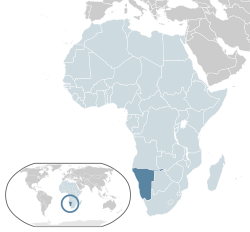Namibia
Guā-māu
Namibia Kiōng-hô-kok Republic of Namibia | |
|---|---|
|
Chu-kù: Unity, Liberty, Justice "thoân-kiat, chū-iû, chèng-gī" | |
|
Kok-koa: Namibia, Land of the Brave "Namibia, ióng-kám ê thó͘-tē" | |
 | |
| Siú-to͘ kap siāng-tōa siâⁿ-chhī | Windhoek |
| Koaⁿ-hong gí-giân | Eng-gí |
| Sêng-jīn ê kok-ka gí-giân | Afrikaans-gí, Tek-gí, Herero-gí, Khoekhoe-gí, Ovambo-gí, Kwangali-gí, Tswana-gí, Lozi-gí |
| sêng-jīn ê tē-hng gí-giân | !Kung-gí, Gciriku-gí, Mbukushu-gí |
| Chèng-hú | tan-it-chè, it-tóng iu-sè, poàn-chóng-thóng-chè, kiōng-hô-kok |
• chóng-thóng | Nangolo Mbumba |
• hù-chóng-thóng | Netumbo Nandi-Ndaitwah |
• chóng-lí | Saara Kuugongelwa-Amadhila |
• hù-chóng-lí | vacant |
• Choè-ko hoat-koaⁿ | Peter Shivute |
| Li̍p-hoat ki-kò͘ | Gī-hoē |
• Siōng-īⁿ | Kok-bîn Phêng-gī-hoē |
• Hā-īⁿ | Kok-bîn Gī-hoē |
| Bīn-chek | |
• Lóng-chóng | 825,615 km2 (318,772 sq mi) (tē 34 miâ) |
| Jîn-kháu | |
• 2020 nî kó͘-kè | 2,550,226 (tē 140 miâ) |
• 2011 nî phó͘-cha | 2,113,077 |
• Bi̍t-tō͘ | 3.2/km2 (8.3/sq mi) (tē 235 miâ) |
| GDP (PPP) | 2021 nî kó͘-kè |
• Lóng-chóng | $23.855 cha̍p-ek |
• Pêng-kin | $9,542 |
| GDP (bêng-gī) | 2021 nî kó͘-kè |
• Lóng-chóng | $10.927 cha̍p-ek |
• Pêng-kin | $4,371 |
| Gini (2015 nî) |
59.1 ko |
| HDI (2019 nî) |
tiong · tē 130 miâ |
| Hoè-pè |
Namibia dollar (NAD) Lâm-hui rand (ZAR) |
| Sî-khu | UTC+2 (CAST) |
| Khui-chhia hong-hiòng | chó |
| Tiān-oē khu-hō | +264 |
| ISO 3166 tāi-hō | NA |
| Siōng-téng domain | .na |
Namibia Kiōng-hô-kok tiàm-tī Hui-chiu sai-lâm ("sai-lâm-hui"), Tāi-se-iûⁿ hái-hōaⁿ piⁿ--a. Keh-piah ū Angola (pak), Zambia (pak), Botswana (tang), Lâm-hui-kok (lâm). 1990 nî thoat-lî Lâm-hui-kok.
|



